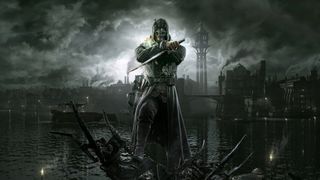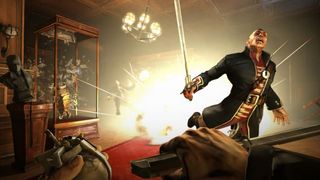Saying one last goodbye to Dishonored
"It's the little details that other developers might overlook."


In Now Playing articles PC Gamer writers talk about the game currently dominating their spare time. Today Chris savours the systemic integrity of the first Dishonored.
I’ve played Dishonored enough times to know that, as I return to the Hound Pits pub in the penultimate chapter, I can start to game the chaos system a little bit. I’ve undertaken this latest, perhaps final playthrough to see off a game I love. I also wanted to have completed a run where I made all the decisions that I now know to be “canon”—branding but otherwise sparing the High Overseer, letting Daud go, and so on. Given that Arkane’s official version of Corvo is a merciful sort, this has meant taking a predominantly stealthy approach.
Which, in turn, means leaving most of Dishonored’s most lethal gadgets and techniques behind. Yet at this late point in the game I know I could kill more or less every corrupt guardsman patrolling the Hound Pits and have no impact on the ending, which is determined by the amount of chaos you cause over the entire campaign. So that’s what I do.
Perhaps Corvo has simply had enough. Betrayed by two successive groups of conspirators, left for dead and forced to reclaim his gear by doing a jumping puzzle, it’s time for him to demonstrate why he bothers to carry a sword in the first place.

I sprint out of the apartments opposite the pub and slide towards a low wall with two guardsmen and a tallboy walker on the other side. As I do I freeze time, pull out my crossbow, and aim a bolt at the neck of each guardsman. Then I leap into a magic-assisted double jump, grabbing the tallboy’s pilot and skewering him through a gap in his armour. Time resumes as the tallboy and I crash to the ground, both guardsmen yelping in surprise as the bolts find their mark.
There’s a shout, and a guard emerges from the pub. I blink behind him and slit his throat. Another guard lowers a pistol. I dash, slide beneath the shot, knock him off-balance, and slash his belly. A few exhilarating, bloody minutes later every single adversary in the pub is dead. The last kill is almost an anticlimax: the final guardsman patrols the stairwell, sword drawn, easy prey.
A few exhilarating, bloody minutes later every single adversary in the pub is dead.
I’ve done this many times, and written in praise of this game many times, but it’s a testament to Dishonored that after all this time I’m still surprised by how well-built it is. It’s easy to fixate on the big things, but Dishonored is as good as it is because of the little details other developers might overlook. Sliding feet-first into enemies knocks them back. There is a split second between when an enemy has seen you and when they overcome their surprise and react, during which they are vulnerable. Sword swings collide with scenery appropriately, and this can be manipulated when you know that guards are right-handed—particularly in an enclosed space like a bar.
The more I learn about game design, the more impressive these small but vital touches become. Each new interaction you discover increases your willingness to experiment. The key to immersive sims like this is the notion that if something should work, it does work, and the fact that Dishonored still rewards experimentation years on is testament to Arkane’s talent—which I suppose is a fancy way of saying “it’s not a real immersive sim if you can’t slide-tackle somebody in the balls and have them react accordingly."
PC Gamer Newsletter
Sign up to get the best content of the week, and great gaming deals, as picked by the editors.
Joining in 2011, Chris made his start with PC Gamer turning beautiful trees into magazines, first as a writer and later as deputy editor. Once PCG's reluctant MMO champion , his discovery of Dota 2 in 2012 led him to much darker, stranger places. In 2015, Chris became the editor of PC Gamer Pro, overseeing our online coverage of competitive gaming and esports. He left in 2017, and can be now found making games and recording the Crate & Crowbar podcast.
Most Popular





